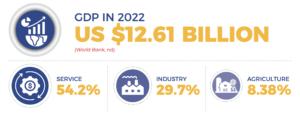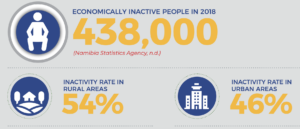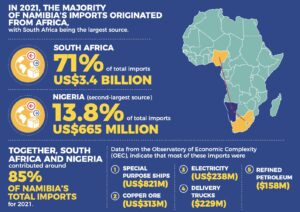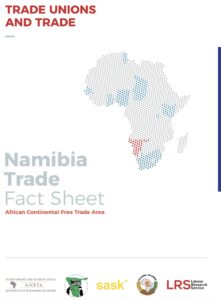The Namibia Trade Fact Sheet provides a snapshot of international trade, offering insights to support trade union advocacy on trade and the African Continental Free Trade Area (AfCFTA) in Namibia. It draws on national and international data to highlight the country’s demographics, macroeconomics, labour market, export processing zones, industrial policy, labour migration, and international trade. The analysis of international trade focuses on its contributions to revenue, balance of payments, main export destinations, and import sources.
Key insights
Demographics and economic indicators
A predominantly young population, with 73 percent under the age of 35 in 2023.
Inflation has been below 10 percent since 2015.
GDP in 2022 was US$12.61 billion, with the services sector contributing over half of this amount.

Source: Namibia Trade Fact Sheet
Labour market overview
Unemployment rate of 29.9 percent in 2022, with youth unemployment at 46.1 percent.
About 58 percent of the workforce is employed in the informal economy. Women are more likely to work informally (61 percent) compared to men (54 percent). Agriculture is the largest employment sector, engaging 23 percent of the workforce.
Trade union membership was about 178,200 in 2020.
Angola was the leading source of migrant workers, constituting 62.02% of the total migrant workforce (2018).

Source: Namibia Trade Fact Sheet
International trade
Exports
South Africa and Nigeria contributed around 85 percent of Namibia’s total imports in 2021, showing the significance of Namibia’s intra-Africa trade.

Source: Namibia Trade Fact Sheet
Exports
China and South Africa received 34 percent and 31 percent of the country’s total exports in 2021.
Resource: Namibia Trade Fact Sheet: Trade unions, trade and AfCFTA
RELATED RESOURCES
- Kenya Trade Fact Sheet: Trade unions, trade and AfCFTA
- South Africa Trade Fact Sheet: Trade unions, trade and AfCFTA
- Nigeria Trade Fact Sheet: Trade unions, trade and AfCFTA
Nelly Nyagah
Nelly Nyagah is the Head of Communications at Labour Research Service.



